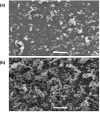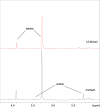Utilization and accumulation of compatible solutes in Halomonas pacifica: a species of moderately halophilic bacteria isolated from a saline lake in South Libya
- PMID: 36003353
- PMCID: PMC9394535
- DOI: 10.1099/acmi.0.000359
Utilization and accumulation of compatible solutes in Halomonas pacifica: a species of moderately halophilic bacteria isolated from a saline lake in South Libya
Abstract
When grown in high salt concentrations, halophilic bacteria often accumulate compatible solutes, which have major applications in biotechnology because they stabilize cells and proteins. Four Gram-negative bacterial strains, belonging to the family Halomonadaceae, were isolated from Qaberoun and Um-Alma lakes in South Libya using high-salinity medium. The strains were identified using 16S rRNA gene sequencing as belonging to Halomonas pacifica (strain ABQ1), Halomonas venusta (ABQ2), Halomonas elongata (ABU1) and Halomonas salifodinae (ABU2). H. pacifica ABQ1 is a moderate halophile (salinity range 0.05 to 2.5 M NaCl), with a broad tolerance to pH (7 to 9) and temperature (25-37 °C). Addition of the compatible solutes glycine betaine (betaine) and ectoine (1,4,5,6-tetrahydro-2-methyl-4-pyrimidine carboxylic acid) to the medium had a positive effect on growth of H. pacifica at 2 M NaCl. In rich LB medium, betaine was the major compatible solute accumulated, with ectoine only being accumulated at salinities in excess of 1 M NaCl. In minimal M9 medium, betaine was not produced, but increasing amounts of ectoine were synthesized with increasing salinity, and hydroxyectoine [(4S,5S)-5-hydroxy-2-methyl-1,4,5,6-tetrahydropyrimidine-4-carboxylic acid] was also synthesized when the cells were grown in very high salt. We have thus identified H. pacifica as a producer of ectoine and hydroxyectoine, with more being produced at higher salinities. As industrial demand for these compatible solutes continues to increase, this system has biotechnological potential.
Keywords: Halomonas bacteria; compatible solutes; ectoine; extreme environments; halophilic bacteria.
© 2022 The Authors.
Conflict of interest statement
The authors declare that there are no conflicts of interest.
Figures








Similar articles
-
The ectD gene, which is involved in the synthesis of the compatible solute hydroxyectoine, is essential for thermoprotection of the halophilic bacterium Chromohalobacter salexigens.J Bacteriol. 2006 Jun;188(11):3774-84. doi: 10.1128/JB.00136-06. J Bacteriol. 2006. PMID: 16707670 Free PMC article.
-
Betaine accumulation suppresses the de-novo synthesis of ectoine at a low osmotic concentration in Halomonas sp SBS 10, a bacterium with broad salinity tolerance.Mol Biol Rep. 2019 Oct;46(5):4779-4786. doi: 10.1007/s11033-019-04924-2. Epub 2019 Jun 22. Mol Biol Rep. 2019. PMID: 31230183
-
Physiological response of the moderately halophilic psychrotolerant strain Chromohalobacter sp. N1 to salinity change and low temperature.Can J Microbiol. 2021 Apr;67(4):342-348. doi: 10.1139/cjm-2020-0299. Epub 2021 Mar 5. Can J Microbiol. 2021. PMID: 33666508
-
Microbial production of ectoine and hydroxyectoine as high-value chemicals.Microb Cell Fact. 2021 Mar 26;20(1):76. doi: 10.1186/s12934-021-01567-6. Microb Cell Fact. 2021. PMID: 33771157 Free PMC article. Review.
-
[Study progress on compatible solutes in moderately halophilic bacteria].Wei Sheng Wu Xue Bao. 2007 Oct;47(5):937-41. Wei Sheng Wu Xue Bao. 2007. PMID: 18062278 Review. Chinese.
Cited by
-
An animal charcoal contaminated cottage industry soil highlighted by halophilic archaea dominance and decimation of bacteria.World J Microbiol Biotechnol. 2024 Sep 20;40(10):327. doi: 10.1007/s11274-024-04136-2. World J Microbiol Biotechnol. 2024. PMID: 39299940
References
-
- Gilmour DJ. In: Microbiology of Extreme Environments. Edwards C, editor. Milton Keynes: Open University Press; 1990. Halotolerant and halophilic microorganisms; pp. 147–177.
LinkOut - more resources
Full Text Sources
Research Materials
